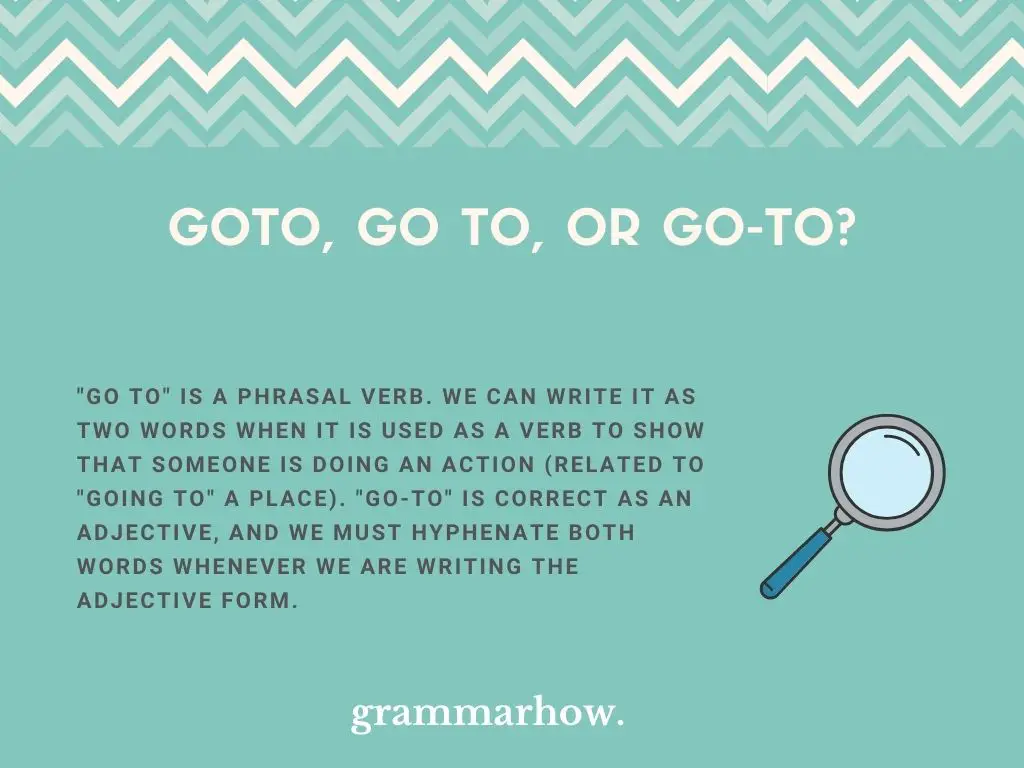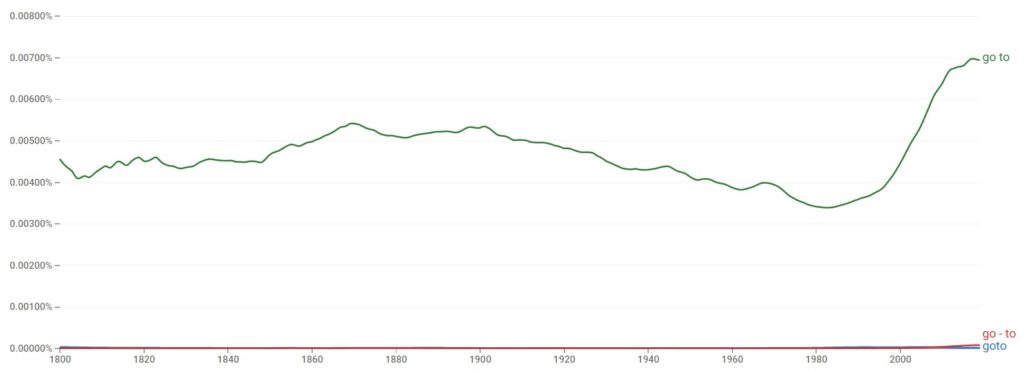Is “go to” written as one or two words? That’s the question we’ll be answering in this article. Sometimes, you might see it hyphenated, and it would help to know why this might be the case, depending on the writing’s context.
Go to vs. Go-to vs. Goto
“Go to” is a phrasal verb. We can write it as two words when it is used as a verb to show that someone is doing an action (related to “going to” a place). “Go-to” is correct as an adjective, and we must hyphenate both words whenever we are writing the adjective form.

According to Google Ngram Viewer, “go to” is vastly more popular than the other two variations. It would seem that the results of this graph prove that “go to” is the only officially recognized spelling variation, but that’s only because it’s so popular compared to the others.

If we removed “go to” to check how popular “go-to” is as a hyphenated form, we’re left with this graph from Google Ngram Viewer. This shows that “go-to” is also correct when it is hyphenated, and we can write it as such.

The Cambridge Dictionary and The Oxford Dictionary define “go to” as a phrasal verb. There are plenty of entries using it with some different examples that show how it can vary based on our verb choices.
Both dictionaries also mention that “go-to” is correct when hyphenated. They both make a note to show that it’s an adjective and that it must come with a modified noun (either before or after it).
If you’re stumped about the differences between verbs and adjectives, you can refer to the following:
- Verb: You should go to the park with him.
- Adjective: I’m the go-to man for this situation!
Is “Goto” One Word?
“Goto” can never be written as one word. It’s the only version of the three in this article that is never officially recognized. There is no reason to group them together because we rely on the hyphen to help show that a modification is taking place.
These examples should help you with it:
- Correct: We will go to the cinema tomorrow, and I’ll make sure to bring the popcorn.
- Incorrect: You can’t goto the principal’s office looking like that!
- Correct: That’s my go-to product whenever I’m looking to improve my skin tone.
- Incorrect: I haven’t got a goto guy anymore to help me out with this rubbish!
Is “Go to” Two Words?
We can write “go to” as two words when it is a phrasal verb. In this way, we are using it to describe someone’s actions. It is an extension of the more familiar verb “go,” but we use the preposition “to” to show a specific thing or direction.
Check out some of these examples to help you:
- We should go to the funeral at some point to pay our respects.
- I would like to go to that country, but I’m not entirely sure if I’ll be allowed in.
- She really has to go to the bathroom! Do you think you could let her?
- I shall go to find out the truth, but I really don’t want to be in a room with him for too long.
Is “Go-to” Hyphenated?
You can hyphenate “go-to” when using it as an adjective. We can refer to AP Style rules whenever we want to learn how hyphenation rules impact different nouns. If multiple words modify the same noun, a hyphen is required between them.
The AP Stylebook teaches us that hyphens can link multiple words together. Since “go” and “to” are both used to modify the noun in the sentence, a hyphen is suitable to show this connection.
Here are a couple of examples to help you:
- My go-to girl for make-up is out of town.
- You’re my go-to! I’ll always come to you first before I consider anyone else.
- I’m not the go-to person for this anymore. Sean is.
- That’s my go-to restaurant! It’s got great food!
Is “To” Capitalized In The Word “Go-To”?
You don’t usually have to capitalize either part of “go-to” in your writing. It’s not a proper noun, so capitalization should be a secondary thought.
The only time you might choose to capitalize both “go” and “to” in the hyphenated form is when you write it in a title. If you capitalize all the words in your title, you should also capitalize both parts of the hyphen form.

Martin holds a Master’s degree in Finance and International Business. He has six years of experience in professional communication with clients, executives, and colleagues. Furthermore, he has teaching experience from Aarhus University. Martin has been featured as an expert in communication and teaching on Forbes and Shopify. Read more about Martin here.
